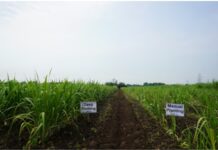BRAZILIAN REAL CREATES OPPORTUNITIES AND CHALLENGES
The week was made shorter because of the July 4 holiday, USA Independence Day, impacting the volumes of businesses and also – as it always happens – delaying the release of the COT (Commitment of Traders), that will only be released by the CFTC next Monday.
October/2024, the first trading contract, closed out the week at the 20.08 cents per pound low, a retraction of 23 points (five dollars per ton) against last Friday’s close. The expectation of rains in the sugarcane regions was the reason presented by some traders and analysts.
The Brazilian real appreciated 2.4% against the dollar in the weekly accumulated, closing out Friday at R$5.4600 after having gotten close to R$5.7000 last week. Several mills took advantage of the surprising stretched quotation of the American currency and fixed part of their export sugar for 2025/2026 and a little of the 2026/2027 crop. Though this strategy was inconceivable three months ago, when the dollar was below R$5.0000, the fact is that the explosion of the American currency against the Brazilian real and the opportunities offered by the financial institutions via NDF (non-deliverable forward contract) inflated the values in real per ton to be received by the mills along the price curve traded in NY – it was the moment to hedge.
On the other hand, given the pressure on the NY quotations with longer maturity because of the curve in real, the industrial consumers could also have the opportunity to fix their purchases of raw material in cents per pound, leaving the dollar open and hoping the American currency will follow the estimate of the Focus bulletin for 2025 and 2026 (R$5.1900) – it was the moment to hedge.
Early this year, we said that we were expecting sugar price to have a support at around 21-22 cents per pound. Back then, the exchange rate was at R$4.9500, and New York was trading sugar at around 24 cents per pound. However, the exchange turnaround, driven not only by external factors but also by President Lula’s verbal compulsion, has brought us to this point. The early support of 21-22 cents per pound had to be adjusted to 18-19 cents per pound. In short, a great part of the sharp downturn in New York over the year (from the 24.62 high to the 17.95 cents per pound low) can be attributed directly to the volatility of the Brazilian real.
In the most recent general price drop last May, the simple average of NY closes for the 2025/2026 crop, that is, of the May/2025 to March/2026 contracts, was 18.25 cents per pound. This Friday it closed out 88 points better, a little over 19 dollars per ton.
I believe that the financial institutions have long positions in the American currency. I say so because we have observed protection offers against the drop of the exchange rate, with the sale of puts of dollar at the exercise price around R$5.4000-5.4500 for a 60-day interval, charging a premium of R$0.07-0.08, which entails a volatility of 13%, a fair price. In other words, the institutions don’t believe the Brazilian real can drop below R$5.3500 over the next 60 days. It’s crucial to monitor this market closely, because early in Lula’s government, these same institutions were long right after the elections, pushing the currency toward R$5.4200, only to see it plummet below R$5.0000 three months later.
Brazil has the seventh greatest dollar reserve of the planet (US$356 billion) and to think that the currency can support high quotations for such a long time is foolhardy. Only a totally out of control situation, if it came true, could make for an impeachment process of the current president. The Foreign Trade Secretariat (SECEX), Brazilian government agency linked to the Economy Ministry and responsible for creating, implementing and coordinating policies and programs related to foreign trading, forecasts a trade balance surplus at US$79.2 billion this year.
Within the sugar market context, I believe that we have already reached lower prices in cents per pound at least as far as the 2025/2026 crop. The 2026/2027 crop can still face pressure due to the NDF curve. The crushing in the Center-South can still surprise us, but any bearish impact on the sugar price would only occur if the crop went beyond 600-605 million tons of sugarcane. The ethanol consumption outlook for the last four-month period of the year is positive and certainly increases the level of sugar support. It seems to us that all negative news pieces are reflecting on New York quotations, though, as we know, there is always the possibility for a black swan to come up.
Sugar sales price fixing in Brazilian real per ton that seems appealing – after all, the Center-South production cost at the most efficient mills hardly ever reaches R$1,800 per FOB ton, all included – should be accompanied by the purchase of a call 200 or 300 points above the market level for the 2025/2026 and 2026/2027 crops, respectively, because this is our price expectation in cents per pound for these crops.Industrial consumers who let themselves be charmed by the market might be in for a surprise.
To conclude, our collaborator Marcelo Moreira’s insight is that after trading at the week’s high at 20.78 cents per pound (and above the moving average of the 200 days), October/2024 closed out the week at 20.08 cents per pound. Now it has important supports at 20.09/19.17/17.92 cents per pound (bottom of the Bollinger band of the 50 days). And a “wall” of resistances at 20.27/20.44/20.66 cents per pound (respectively the moving average of the 100 days/top of the Bollinger band of the 50 days/ moving average of the 200 days). Watch for the possible break of the moving average of the 200 days because it can trigger “stops” driving the market to seek 22.00/22.94 cents per pound!
To read the previous episodes of World Sugar Market – Weekly Comment, click here
To get in touch with Mr. Arnaldo, write on arnaldo@archerconsulting.com.br












